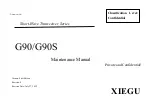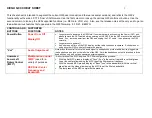
16
Appendix B - TRIUMPH-2 AntCal
Appendix B - TRIUMPH-2 AntCal Data
http://www.ngs.noaa.gov/ANTCAL/Antennas.jsp?manu=Javad
TRIUMPH-2
shown above with its slant height measurement
point (SHMP). The green triangle is also the indication of the
north orientation mark (NOM); the direction the antenna
should be facing when surveying.
PREFACE
ARPs
During its first year in existence, the
TRIUMPH-2
had a special
distinction made by NGS, specifically in regards to its an-
tenna calibration data. During the year 2014, NGS had two
different antenna models: one with the 25mm x 1/4” x 20
threaded adapter [10-590293-01] included and one without
it. The net result related only to the Antenna Reference Point
(ARP).
Beginning in January 2015, and in accordance with the
standardized definition that the ARP is the lowest non-re-
movable part of the antenna, NGS has removed the an-
tenna type model that had included the 25 mm x 1/4” x 20
threaded adapter in its ARP. Accordingly, as of January 2015,
NGS is listing only one model antenna type for the internal
antenna of the
TRIUMPH-2
; the
JAVTRIUMPH_2A
. This is the
first distinction that users need to pay very close attention
to; specifically, their HIs (ARPs) if they have recorded obser-
vations using the
TRIUMPH-2
during the calendar year 2014
and then process those data after 2014.
PCOs and PCVs
Additionally, the second distinction that users need to be
aware of is the antenna calibration data for the internal an-
tenna has been updated. This separate distinction relates to
both
Phase Center Offset
and
Phase Center Variation
values
for the internal antenna of the
TRIUMPH-2
.
The original PCOs and PCVs that the NGS Antenna Cali-
bration team had initially determined in March 2014 have
been superseded by the highly precise values produced
after recalibration on a Geo++ robot. These so-called
near-
field
calibrations included the use of the 25mm x 1/4” x 20
threaded adapter [10-590293-01] and is reflected by the
suffix
A
attached at the end of the antenna model’s name:
JAVTRIUMPH_2A
. Finalization was coordinated through the
International GNSS Service (IGS) in December 2014.
If survey work has been performed with the
TRIUMPH-2
and
processed using the superseded NGS values and which had
critical elevation determinations, users are advised to reex-
amine those projects and to reprocess their data using the
superior antenna model published in January 2015.
Differences in the elevation of surveyed points have been
reported to be as much as 7 cm as improper Phase Center
Variations will cause errors most notably in the vertical com-
ponent in precise GPS surveys.









































